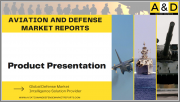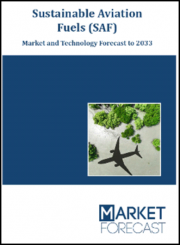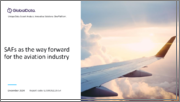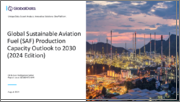
|
시장보고서
상품코드
1321088
세계의 지속가능한 항공 연료 시장(2023-2033년)Global Sustainable Aviation Fuel Market 2023-2033 |
||||||
지속가능한 항공 시장은 친환경 항공 여행에 대한 수요 증가로 빠르게 성장하고 있습니다. 항공 여행이 환경에 미치는 영향에 대한 사람들의 인식이 높아짐에 따라 지속가능한 대안에 대한 수요가 증가하고 있습니다. 세계 각국 정부는 항공 여행의 환경적 영향을 줄이기 위한 규제를 시행하고 있으며, 이에 따라 이러한 요구 사항을 충족하기 위한 새로운 기술과 연료가 필요하게 되었습니다. 최근 기술 발전으로 보다 지속가능한 항공기와 연료를 개발할 수 있게 되었습니다.
지속가능항공연료(SAF)는 재생한 원료나 폐기물을 원료로 하는 항공 연료의 일종입니다. 기존 항공기를 개조하지 않고도 사용할 수 있으며, 온실가스 배출을 최대 80%까지 줄일 수 있으며, 농업, 임업, 도시 폐기물 등의 바이오매스, 폐식용유, 동물성 유지, 폐플라스틱 등의 폐기물 등 다양한 원료를 사용할 수 있습니다. 할 수 있습니다. 또한 대기 중이나 산업 공정에서 이산화탄소를 회수하여 SAF 생산에 활용할 수도 있습니다.
SAF 제조는 복잡한 공정이지만 효율성과 비용 효율성이 향상되고 있으며, SAF 제조에는 하이드로 프로세스, 피셔·트롭시 합성, GTL 등 다양한 기술이 적용될 수 있습니다.
항공기의 이산화탄소 배출을 최소화하기 위한 노력은 액체 바이오연료와 합성 대체 연료를 포함한 지속가능한 항공 연료(SAF) 개발에 초점을 맞추고 있으며, SAF는 화석 연료에 비해 수명 주기가 더 깨끗하기 때문에 배출량을 줄일 수 있습니다.
SAF의 지속가능성을 보장하기 위해서는 환경에 미치는 영향을 최소화하면서 생산량을 늘리는 것이 중요합니다. 바이오연료의 발전에도 불구하고 현재 시나리오에서 일부 바이오연료는 항공이 기후에 미치는 영향을 크게 완화하지 못할 수 있습니다.
SAF는 항공기에 사용되는 바이오연료로, 일반 제트 연료와 유사한 특성을 가지고 있지만 이산화탄소 배출량이 적습니다. 원료와 제조 방법에 따라 SAF는 기존 제트 연료에 비해 수명 주기 동안 온실 가스 배출량을 크게 줄일 수 있습니다. 일부 새로운 SAF는 온실가스 배출량이 마이너스인 경우도 있습니다. 재생한 자원과 폐기물로 SAF를 육성, 조달, 생산함으로써 지방에 경제 기회를 창출하고 환경을 개선하며 항공기 성능을 향상시킬 수 있으며, SAF는 방향족 성분이 적어 항공기 엔진의 연소를 더 깨끗하게 만들어 이착륙시 공항 주변에 배출되는 유해 가스의 양을 줄일 수 있습니다. 유해한 가스의 양을 줄일 수 있습니다. 또한 이러한 방향족 성분은 비행운 형성에 기여하여 기후 변화의 영향을 악화시킬 수 있습니다.
지속가능한 항공 연료 시장의 성장을 이끄는 원동력은 각국 정부가 항공 여행이 환경에 미치는 영향을 줄이기 위한 규제를 시행하는 것과 보다 지속가능한 항공기와 연료를 개발할 수 있는 기술 발전입니다.
시장 역학적으로 볼 때, 바이오연료 기술 분야가 가장 널리 보급되어 시장 점유율의 대부분을 차지하고 있습니다. 또한 민간 항공 분야가 가장 큰 용도로 시장 점유율에 가장 큰 기여를 하고 있습니다.
최근 IAG Cargo는 Kuehne Nagel과 협력하여 2023년까지 6백만 리터의 SAF를 구매하여 화물 고객의 공급망 배출을 줄이는데 주력하고 있습니다. 사용 후 식용유와 음식물 쓰레기로 만든 SAF는 ISCC(International Sustainability & Carbon Certification) 인증을 받았으며, 기존 제트 연료보다 수명 주기 배출량이 최소 80% 이상 적고, 15,000 톤 이상의 CO2를 절감합니다.
세계의 지속가능한 항공 연료(SAF) 시장에 대해 분석했으며, 전체 시장 규모 동향 전망, 지역별·국가별 상세 동향, 주요 기술 개요, 시장 기회 등을 조사하여 전해드립니다.
목차
지속가능한 항공 연료 시장 : 분석의 정의
지속가능한 항공 연료 시장 세분화
- 원료별
- 최종사용자별
- 지역별
지속가능한 항공 연료 시장 분석 : 향후 10년간
지속가능한 항공 연료 시장의 시장 기술
세계의 지속가능한 항공 연료 시장 예측
지속가능한 항공 연료 시장 : 지역별 동향과 예측
북미
- 촉진·억제요인, 과제
- PEST 분석
- 시장 예측과 시나리오 분석
- 주요 기업
- 공급업체 계층 상황
- 기업 벤치마킹
- 유럽
- 중동
- 아시아태평양
- 남미
지속가능한 항공 연료 시장 : 국가별 분석
미국
- 방위 계획
- 최신 동향
- 특허
- 이 시장에서 현재의 기술 성숙 레벨
- 시장 예측과 시나리오 분석
- 캐나다
- 이탈리아
- 프랑스
- 독일
- 네덜란드
- 벨기에
- 스페인
- 스웨덴
- 그리스
- 호주
- 남아프리카공화국
- 인도
- 중국
- 러시아
- 한국
- 일본
- 말레이시아
- 싱가포르
- 브라질
지속가능한 항공 연료 시장 : 시장 기회 매트릭스
지속가능한 항공 연료 시장 : 분석에 관한 전문가의 견해
결론
KSA 23.08.11The sustainable aviation market is experiencing rapid growth due to the increasing demand for eco-friendly air travel. Public awareness of the environmental impact of air travel is rising, leading to a higher demand for sustainable alternatives. Governments worldwide are implementing regulations to reduce air travel's environmental footprint, resulting in a need for new technologies and fuels to meet these requirements. Recent technological advancements are enabling the development of more sustainable aircraft and fuels.
Sustainable aviation fuel (SAF) is a type of aviation fuel derived from renewable or waste feedstocks. It can be used in existing aircraft without modifications and has the potential to reduce greenhouse gas emissions by up to 80%. Various feedstocks can be used to produce SAF, including biomass from agricultural, forestry, and municipal waste, as well as waste materials like used cooking oil, animal fats, and waste plastics. Carbon dioxide can also be captured from the atmosphere or industrial processes and used to produce SAF.
The production of SAF is a complex process, but it is becoming more efficient and cost-effective. Different technologies, such as hydroprocessing, Fischer-Tropsch synthesis, and GTL, can be employed to produce SAF.
Efforts to minimize aircraft carbon emissions are focused on developing sustainable aviation fuels (SAFs), including liquid biofuels and synthetic alternatives. SAFs offer the potential to reduce emissions due to their cleaner life cycle compared to fossil fuels.
To guarantee the sustainability of SAFs, increasing production while minimizing environmental impact is crucial. Despite advancements, some biofuels may not significantly mitigate aviation's climate impact in current scenarios.
SAF is a biofuel used in airplanes with similar properties to regular jet fuel but with a lower carbon footprint. Depending on the feedstock and production methods, SAF can significantly reduce life cycle greenhouse gas emissions compared to traditional jet fuel. Some new SAF approaches even exhibit negative greenhouse gas footprints. The growth, sourcing, and production of SAF from renewable and waste sources can create economic opportunities in rural areas, improve the environment, and enhance aircraft performance. SAFs often have fewer aromatic components, leading to cleaner combustion in airplane engines, resulting in fewer harmful emissions around airports during takeoff and landing. Additionally, these aromatic components can contribute to the formation of contrails, which exacerbate climate change effects.
The sustainable aviation fuel market's growth is driven by governments implementing regulations to reduce air travel's environmental impact and the advancements in technology enabling the development of more sustainable aircraft and fuels.
In terms of market dynamics, the biofuel technology segment is the most popular, accounting for the majority of the market share. Additionally, commercial aviation is the largest application segment, contributing the most to the market share.
Recent developments include IAG Cargo collaborating with Kuehne+Nagel to reduce cargo customers' supply chain emissions by purchasing six million liters of SAF in 2023. The SAF, made from used cooking oil and food waste, is certified by the International Sustainability & Carbon Certification (ISCC) and has at least 80% lower lifecycle emissions than conventional jet fuel, saving over 15,000 tonnes of CO2.
Table of Contents
Sustainable Aviation Fuel Market Report Definition
Sustainable Aviation Fuel Market Segmentation
- By Source
- By End Users
- By Region
Sustainable Aviation Fuel Market Analysis for next 10 Years
- The 10-year sustainable aviation fuel market analysis would give a detailed overview of sustainable aviation fuel market growth, changing dynamics, technology adoption overviews and the overall market attractiveness is covered in this chapter.
Market Technologies of Sustainable Aviation Fuel Market
- This segment covers the top 10 technologies that is expected to impact this market and the possible implications these technologies would have on the overall market.
Global Sustainable Aviation Fuel Market Forecast
- The 10-year access control market forecast of this market is covered in detailed across the segments which are mentioned above.
Regional Sustainable Aviation Fuel Market Trends & Forecast
- The regional sustainable aviation fuel market trends, drivers, restraints and Challenges of this market, the Political, Economic, Social and Technology aspects are covered in this segment. The market forecast and scenario analysis across regions are also covered in detailed in this segment. The last part of the regional analysis includes profiling of the key companies, supplier landscape and company benchmarking. The current market size is estimated based on the normal scenario.
North America
- Drivers, Restraints and Challenges
- PEST
- Market Forecast & Scenario Analysis
- Key Companies
- Supplier Tier Landscape
- Company Benchmarking
- Europe
- Middle East
- APAC
- South America
Country Analysis of Sustainable Aviation Fuel Market
- This chapter deals with the key defense programs in this market, it also covers the latest news and patents which have been filed in this market. Country level 10 year market forecast and scenario analysis are also covered in this chapter.
US
- Defense Programs
- Latest News
- Patents
- Current levels of technology maturation in this market
- Market Forecast & Scenario Analysis
- Canada
- Italy
- France
- Germany
- Netherlands
- Belgium
- Spain
- Sweden
- Greece
- Australia
- South Africa
- India
- China
- Russia
- South Korea
- Japan
- Malaysia
- Singapore
- Brazil
Opportunity Matrix for Sustainable Aviation Fuel Market
- The opportunity matrix helps the readers understand the high opportunity segments in this market.
Expert Opinions on Sustainable Aviation Fuel Market Report
- Hear from our experts their opinion of the possible analysis for this market.
Conclusions
- About Aviation and Defense Market Reports



















